Another January, another annual data point.
As in years past, the annual rollout of the GISTEMP, NOAA, HadCRUT and Berkeley Earth analyses of the surface temperature record have brought forth many stories about the long term trends and specific events of 2022 – mostly focused on the impacts of the (ongoing) La Niña event and the litany of weather extremes (UK and elsewhere having record years, intense rainfall and flooding, Hurricane Ian, etc. etc.).
But there are a few things that don’t get covered much in the mainstream stories, and so we can dig into them a bit here.
What influence does ENSO really have?
It’s well known (among readers here, I assume), that ENSO influences the interannual variability of the climate system and the annual mean temperatures. El Niño events enhance global warming (as in 1998, 2010, 2016 etc.) and La Niña events (2011, 2018, 2021, 2022 etc.) impart a slight cooling.
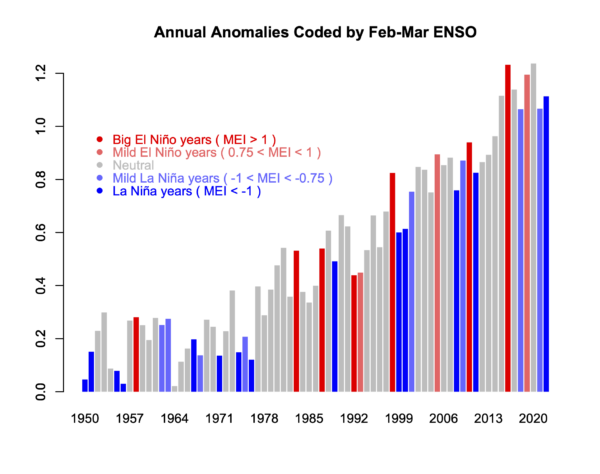
Consequently, a line drawn from an El Niño year to a subsequent La Niña year will almost always show a cooling – a fact well known to the climate disinformers (though they are not so quick to show the uncertainties in such cherry picks!). For instance, the trends from 2016 to 2022 are -0.12±0.37ºC/dec but with such large uncertainties, the calculation is meaningless. Far more predictive are the long term trends which are consistently (now) above 0.2ºC/dec (and with much smaller uncertainties ±0.02ºC/dec for the last 40 years).
It’s worth exploring quantitatively what the impact is, and this is something I’ve been looking at for a while. It’s easy enough correlate the detrended annual anomalies with the ENSO index (maximum correlation is for the early spring values), and then use that regression to estimate the specific impact for any year, and to estimate an ENSO-corrected time series.
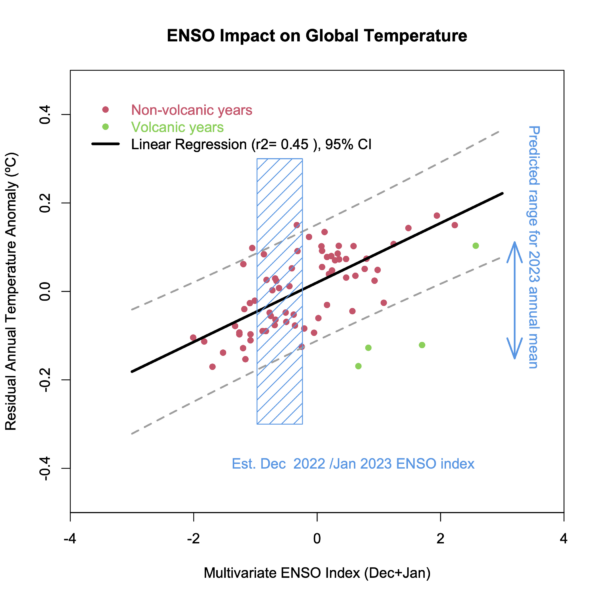
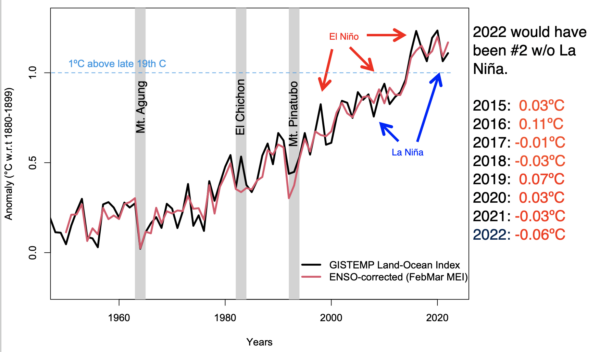
The surface temperature records are becoming more coherent
Back in 2013/2014, the differences between the surface indices (HadCRUT3, NOAA v3 and GISTEMP v3) contributed to the initial confusion related to the ‘pause’, which was seemingly evident in HadCRUT3, but not so much in the other records (see this discussion from 2015). Since then all of the series have adopted improved SST homogenization, and HadCRUT5 adopted a similar interpolation across the pole as was used in the GISTEMP products. From next month onwards, NOAA will move to v5.1 which will now incorporate Arctic buoy data (a great innovation) and also provide a spatially complete record. The consequence is that the surface instrument records will be far more coherent than they have ever been. Some differences remain pre-WW2 (lots of SST inhomogeneities to deal with) and in the 19th C (where data sparsity is a real challenge).
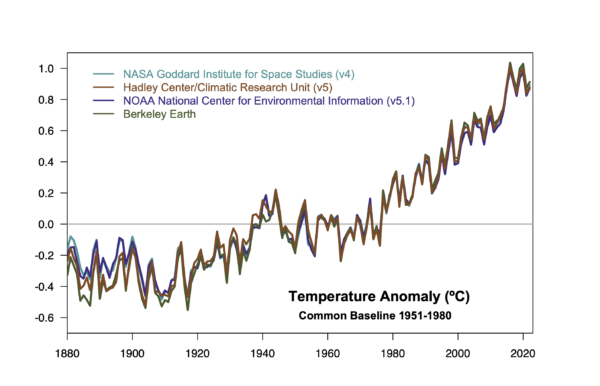
The structural uncertainty in satellite records is large
While the surface-based records are becoming more consistent, the various satellite records are as far apart as ever. The differences between the RSS and UAH TLT records are much larger than the spread in the surface records (indeed, they span those trends), making any claims of greater precision somewhat dubious. Similarly, the difference in the versions of the AIRS records (v6 vs. v7) of ground temperature anomalies produce quite distinct trends (in the case of AIRS v6, Nov 2022 was exceptionally cold, which was not seen in other records).
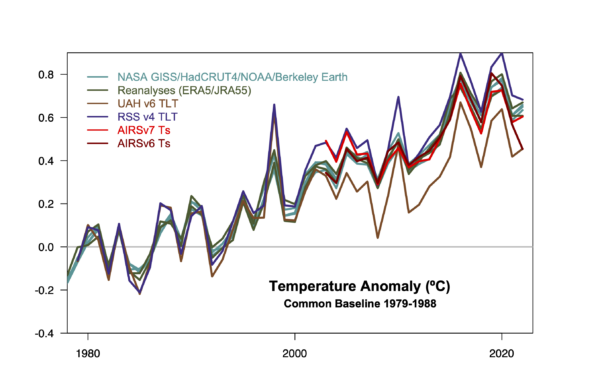
When will we reach 1.5ºC above the pre-industrial?
This was a very common question in the press interviews this week. It has a few distinct components – what is the ‘pre-industrial’ period that’s being referenced, what is the uncertainty in that baseline, and what are the differences in the long term records since then?
The latest IPCC report discusses this issue in some depth, but the basic notion is that since the impacts that are expected at 1.5ºC are derived in large part from the CMIP model simulations that have a nominal baseline of ~1850, ‘pre-industrial’ temperatures are usually assumed to be some kind of mid-19th Century average. This isn’t a universally accepted notion – Hawkins et al (2017) for instance, suggest we should use a baseline from the 18th Century – but it is one that easier to operationalise.
The baseline of 1880-1900 can be calculated for all the long temperature series, and with respect to that 2022 (or the last five years) is between 1.1 and 1.3ºC warmer (with Berkeley Earth showing the most warming). For the series that go back to 1850, the difference between 1850-1900 and 1880-1900 is 0.01 to 0.03ºC, so probably negligible for this purpose.
Linear trends since 1996 are robustly just over 0.2ºC/decade in all series, so that suggests between one and two decades are required to have the mean climate exceed 1.5ºC, that is around 2032 to 2042. The first specific year that breaches this threshold will come earlier and will likely be associated with a big El Niño. Assuming something like 2016 (a +0.11ºC effect), that implies you might see the excedence some 5 years earlier – say 2027 to 2037 (depending a little on the time-series you are following).
2023 is starting the year with a mild La Niña, which is being forecast to switch to neutral conditions by mid-year. Should we see signs of an El Niño developing towards the end of the year, that will heavily favor 2024 to be a new record, though not one that is likely to exceed 1.5ºC however you calculate it.
[Aside: In contrast to my reasoning here, the last decadal outlook from the the UK MetOffice/WMO suggested that 2024 has a 50-50 chance of exceeding 1.5ºC, some 5 or so years early than I’d suggest, and that an individual year might reach 1.7ºC above the PI in the next five years! I don’t know why this is different – it could be a larger variance associated with ENSO in their models, it could be a higher present day baseline (but I don’t think so), or a faster warming rate than the linear trend (which could relate to stronger forcings, or higher effective sensitivity). Any insight on this would be welcome!]
References
- E. Hawkins, P. Ortega, E. Suckling, A. Schurer, G. Hegerl, P. Jones, M. Joshi, T.J. Osborn, V. Masson-Delmotte, J. Mignot, P. Thorne, and G.J. van Oldenborgh, "Estimating Changes in Global Temperature since the Preindustrial Period", Bulletin of the American Meteorological Society, vol. 98, pp. 1841-1856, 2017. http://dx.doi.org/10.1175/BAMS-D-16-0007.1